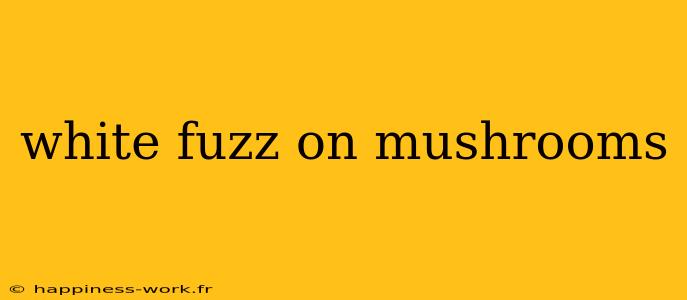Mushrooms are fascinating organisms that often pique curiosity among amateur mycologists and culinary enthusiasts alike. However, if you've stumbled upon white fuzz on mushrooms, you may be wondering whether it's a harmless characteristic or a sign of trouble. In this article, we explore the origins of that fuzzy appearance, how to distinguish between mycelium and mold, and what actions you should take if you find this white fuzz on your mushrooms.
What is the White Fuzz on Mushrooms?
The white fuzz you might see on mushrooms can be attributed to two primary sources: mycelium, which is the vegetative part of fungi, or mold, which can indicate spoilage.
Mycelium
Mycelium is a network of fungal threads (hyphae) that often appears as a white, cottony substance. It is an essential part of the fungal lifecycle, playing a critical role in nutrient absorption and reproduction. Mycelium can often be seen growing on the substrate where mushrooms thrive, particularly if they are still in the cultivation phase.
Mold
On the other hand, mold is generally an undesirable presence on mushrooms and can manifest as fuzzy white spots or patches. Mold can indicate that the mushrooms are old, spoiled, or have been improperly stored. Unlike mycelium, mold can compromise the quality of the mushroom and may pose health risks if consumed.
How to Differentiate Between Mycelium and Mold?
To help you determine whether the white fuzz on your mushrooms is mycelium or mold, consider the following factors:
-
Location: Mycelium typically grows at the base of mushrooms or on the substrate, while mold may appear more sporadically across the surface of the mushroom.
-
Texture: Mycelium has a dense and fibrous texture, whereas mold usually has a more powdery or fuzzy consistency.
-
Smell: Fresh mushrooms with mycelium will have a neutral or earthy smell. Moldy mushrooms often emit a sour or musty odor, indicating spoilage.
-
Appearance: Mycelium tends to be uniform and consistent, while mold can vary in color and texture, sometimes showing signs of discoloration or dark patches.
Practical Example
Imagine you’ve purchased a batch of portobello mushrooms, and you notice a whitish fuzz at the base of one mushroom. If it appears to cover only the bottom and is dense but not sticky, it’s likely mycelium. In contrast, if the mushroom has areas of fuzz that are uneven and you notice a sour smell, it's probably mold.
What to Do if You Find White Fuzz
-
Examine: Carefully inspect the mushrooms. Check for texture, smell, and the areas where the fuzz appears.
-
Discard: If you determine that the white fuzz is mold, it’s best to discard the mushroom. Eating moldy food can pose health risks, particularly for individuals with compromised immune systems.
-
Store Properly: To prevent mold growth, store mushrooms in a cool, dry place. Keeping them in a paper bag can help absorb moisture compared to plastic containers.
-
Harvest Safely: If you’re cultivating mushrooms, ensure you are following safe cultivation practices, including maintaining cleanliness and controlling humidity levels to discourage mold growth.
Conclusion
Understanding the white fuzz on mushrooms is crucial for both safety and culinary enjoyment. By distinguishing between mycelium and mold, you can ensure you're consuming fresh, safe mushrooms while also appreciating the fascinating biology behind these amazing fungi.
Whether you’re an avid mushroom forager or a home cook looking to incorporate mushrooms into your meals, knowledge about these organisms will enhance your experiences in the kitchen and beyond.
Attribution
This article is inspired by the information provided by authors on WikiHow. For detailed guides on mushroom cultivation and maintenance, visit WikiHow.
By employing these guidelines, you can optimize your understanding of mushrooms and make informed decisions in your culinary practices.
